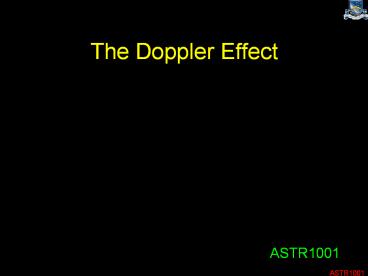The Doppler Effect - PowerPoint PPT Presentation
Title:
The Doppler Effect
Description:
Electromagnetic waves, while all travelling at the same speed, can have ... This star must therefore be travelling towards us at 10% of the speed of light. ... – PowerPoint PPT presentation
Number of Views:995
Avg rating:3.0/5.0
Title: The Doppler Effect
1
The Doppler Effect
- ASTR1001
2
Spectroscopy
- When the media covers astronomy, they nearly
always show pretty pictures. This gives a biassed
view of what astronomers actually do well over
70 of all observations are not pictures - they
are spectra. - Spectra are the most vital tool of astronomy -
without them wed be lost. However, they are
slightly more complicated to understand than
pictures (and nothing like as pretty), so the
media ignores them. - Light is made up of waves of entwined electricity
and magnetism. This applies to all types of
light, including radio waves and X-rays. The
general term for these waves is Electromagnetic
Waves. - These waves always travel at the same speed
300,000 kilometres per second.
3
Wavelengths
- Electromagnetic waves, while all travelling at
the same speed, can have different wavelengths
(the distance between the crest of one wave and
the next). - It is the wavelength that determines what type of
light you have.
4
The Electromagnetic Spectrum
- Electromagnetic waves can have any wavelengths at
all anywhere from picometres to light-years.
- These are all basically the same things waves of
entwined electricity and magnetism flying through
space the only thing thats different is the
wavelength. You also get waves longer than radio
and shorter than Gamma Rays - but these are very
rare, and as far as we know useless (at present).
Our eyes are only sensitive to visible light.
5
Spectrographs
- A spectrograph separates light out into its
component wavelengths separating the long
wavelength light from the short. - They can either use a prism or a device called a
diffraction grating (like the bottom of a cd).
6
- We plot spectra as graphs graphs showing
precisely how much power the thing we are looking
at emits at each precise wavelength. - Spectra are incredibly useful. Luckily, all
chemicals emit and absorb light at certain very
specific wavelengths. A typical spectrum (like
this spectrum of gas spiraling into a black hole)
can be used to identify the composition of the
gas.
To an expert (like me), every bump and wiggle in
a spectrum like this tells a story of what the
gas is made of, how its moving, and how hot it
is.
Strength of light at this wavelength
Wavelength (nm)
7
Whats this got to do with velocities?
- Well, the waves of electromagnetic radiation
coming from some distant object can be used to
see whether that object is moving away from us or
towards us. - If the waves are bunched unusually close
together, the object must be moving towards us.
This would mean that all the bumps and wiggles in
a spectrum would appear to be at slightly shorter
wavelengths than usual. - If they are unusually spread apart, the object
must be moving away from us. All the bumps and
wiggles will be at slightly longer wavelengths
than usual. - This effect is called the Doppler Effect. It is
widely used on Earth, for such things as radar
and speed traps.
8
The Doppler Effect
The wavelength is reduced here
and increased here
9
How does this affect the spectra?
Stationary Star
Star moving away from us
Star moving towards from us
Strength of the Light with this Wavelength
Wavelength
10
The Maths
- How big is this effect? A full account requires
relativity, but as long as your velocity is a
small fraction of the speed of light, the
fractional shift in wavelength is equal to the
velocity divided by the speed of light. - Where Dl is the change in the wavelength of some
spectral feature, Df is the change in its
frequency, v is the radial velocity, and c the
speed of light.
11
Example.
- If, for example, a particular emission line is
normally seen at a wavelength of 10 nm, but we
observe it in the spectrum of a star at 9nm, then
Dl (10-9). L10, so Dl/l 1/10. - This star must therefore be travelling towards us
at 10 of the speed of light.

